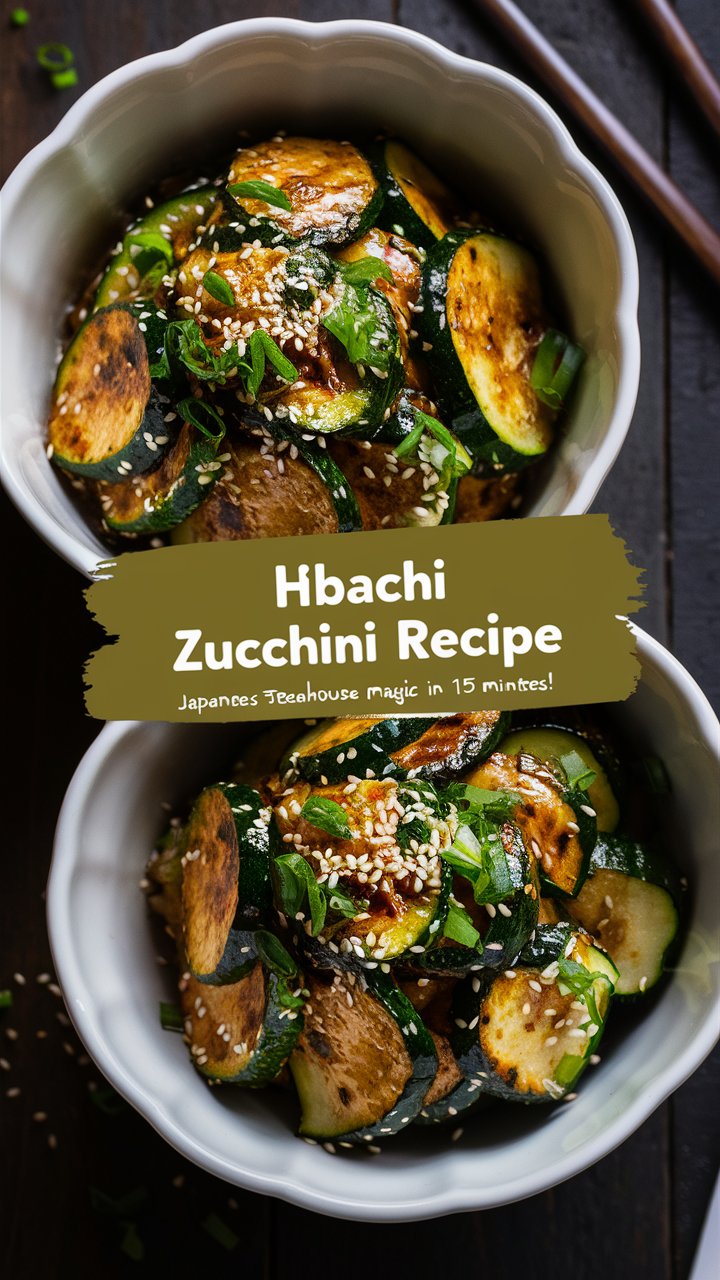
The Best Hibachi Zucchini Stir Fry Recipe You’ll Ever Try 2025
If you’ve ever been to a Japanese steakhouse or hibachi grill, you probably remember the sizzle of vegetables on the hot griddle, the irresistible aroma of garlic and sesame, and the lively showmanship of the chefs. Among the many highlights of hibachi dining, zucchini stir fry stands out as a humble yet flavor-packed side dish that perfectly balances smoky char, savory soy, and a touch of natural sweetness.
The beauty of hibachi zucchini stir fry lies in its simplicity. In less than 15 minutes, you can recreate this restaurant-style dish at home with just a handful of ingredients. Quick, healthy, and versatile, it’s a perfect side for rice, noodles, grilled proteins, or even as a standalone light meal.
In this article, you’ll discover not just the recipe itself, but also pro-level cooking tips, flavor variations, serving ideas, nutritional insights, and answers to the most common questions. By the end, you’ll have everything you need to master hibachi zucchini and make it a regular star at your dinner table.
Why This Hibachi Zucchini Stir Fry Belongs in Your Kitchen
There are countless vegetable side dishes out there, but hibachi zucchini stir fry has some unique advantages:
- Fast & easy: Done in under 15 minutes.
- Healthy: Low in calories but packed with vitamins, minerals, and fiber.
- Flavorful: Layers of garlic, ginger, soy sauce, and sesame oil give it an authentic hibachi taste.
- Versatile: Pairs beautifully with rice, fried rice, hibachi noodles, grilled chicken, shrimp, or steak.
- Crowd-pleasing: Even picky eaters enjoy the smoky, savory-sweet flavor.
This dish isn’t just a side—it can be adapted into a complete meal by adding tofu, shrimp, or chicken. Whether you’re cooking for a quick weeknight dinner or entertaining guests with a hibachi-style spread, zucchini stir fry is always a hit.
The Origins of Hibachi Cooking
The word hibachi in Japanese literally means “fire bowl,” referring to a traditional heating device used centuries ago. However, what we call “hibachi cooking” in the United States is actually closer to teppanyaki—grilling on a flat iron surface.
American hibachi steakhouses, which became popular in the mid-20th century, combine Japanese-inspired cooking techniques with Western ingredients and flavors. Chefs cook in front of diners, turning the experience into a performance complete with flying spatulas, flaming onion volcanoes, and playful tricks.
Vegetables like zucchini, onions, mushrooms, and carrots became staples of the American hibachi experience because they cook quickly, caramelize beautifully, and complement grilled meats. While zucchini isn’t native to Japan, it has become a beloved part of the hibachi side dish repertoire in the U.S.
Ingredients You’ll Need (and Why They Work)
The secret to hibachi-style cooking is simplicity with balance. Here’s what you need and why each ingredient matters:
- Zucchini: The star of the dish. When cooked over high heat, zucchini develops a slightly smoky, caramelized exterior while staying tender inside.
- Onion: Adds sweetness and depth, balancing zucchini’s mild flavor.
- Garlic & Ginger: Fresh aromatics that build the classic hibachi base flavor.
- Soy Sauce: Brings salty, umami richness. Choose low-sodium if preferred.
- Sesame Oil: Adds a nutty, toasty aroma that defines hibachi vegetables.
- Vegetable Oil: Used for high-heat stir-frying; neutral oils like canola or peanut oil are best.
- Sesame Seeds: Provide crunch and a subtle nutty note.
- Optional Enhancers: Mushrooms, carrots, broccoli, chili oil, or a splash of rice vinegar for brightness.
Step-by-Step Recipe Instructions
Step 1: Prepare the Vegetables
- Cut 2 medium zucchinis into sticks, about 2–3 inches long and ½ inch thick. Uniform size ensures even cooking.
- Peel and slice 1 medium onion into thick wedges or strips.
Step 2: Heat the Pan
- Preheat a large wok or skillet over medium-high to high heat.
- Add 1 tablespoon vegetable oil and swirl to coat.
Step 3: Cook the Onion
- Add the onion slices and stir-fry for about 2 minutes until they begin to soften but still retain some bite.
Step 4: Add Aromatics
- Stir in 1 teaspoon minced garlic and 1 teaspoon minced fresh ginger.
- Cook for 30 seconds until fragrant, being careful not to burn them.
Step 5: Sear the Zucchini
- Add the zucchini sticks.
- Stir-fry for 4–5 minutes, allowing them to brown slightly on the edges while staying crisp-tender.
Step 6: Season the Stir Fry
- Add 2 tablespoons soy sauce and 1 teaspoon sesame oil.
- Toss well to coat evenly.
- Season with a light sprinkle of salt and freshly ground black pepper.
Step 7: Finish with Sesame Seeds
- Sprinkle 1 teaspoon toasted sesame seeds over the vegetables.
- Stir for one more minute until everything looks glossy and well-coated.
Step 8: Serve Hot
- Transfer to a serving dish and enjoy immediately with rice, noodles, or grilled protein of choice.
Expert Cooking Tips for the Best Hibachi Zucchini
- Use high heat: This helps achieve a slight char without overcooking.
- Don’t overcrowd the pan: Cook in batches if needed to avoid steaming.
- Cut zucchini evenly: Uniform sticks cook consistently and look more professional.
- Finish with sesame oil: Add it near the end for maximum flavor; heating it too long diminishes its aroma.
- Control moisture: Salt zucchini lightly after cooking, not before, to avoid drawing out excess water.
Variations & Substitutions
- Protein Boost: Add cubed tofu, shrimp, chicken, or steak to turn this into a full meal.
- Gluten-Free: Swap soy sauce with tamari or coconut aminos.
- Low-Carb: Skip rice and pair with grilled salmon or chicken.
- Spicy Kick: Add chili oil, sriracha, or red pepper flakes.
- Different Veggies: Try bell peppers, mushrooms, snap peas, or broccoli.
- Nutty Twist: Replace sesame seeds with crushed peanuts or cashews.
What to Serve with Hibachi Zucchini Stir Fry
Pairing is what makes hibachi-style meals so satisfying. Try these combinations:
- Carbs: Steamed jasmine rice, fried rice, or hibachi noodles.
- Proteins: Grilled steak, teriyaki chicken, miso-glazed salmon, or shrimp.
- Sauces: Yum yum sauce, spicy mayo, ginger sauce, or ponzu.
- Sides: Miso soup, Asian slaw, cucumber salad, or crispy gyoza.
Storage & Leftovers
- Refrigeration: Store in an airtight container for up to 3 days.
- Reheating: Best reheated in a skillet over medium heat to restore texture.
- Freezing: Not recommended—zucchini becomes mushy when thawed.
Nutritional Benefits of Hibachi Zucchini Stir Fry
Per 1-cup serving (approximate, without added protein):
- Calories: 90
- Protein: 3g
- Fat: 5g
- Carbohydrates: 10g
- Fiber: 2g
- Vitamin C: 35% DV
- Vitamin A: 10% DV
- Potassium: 15% DV
Zucchini is rich in antioxidants like lutein and zeaxanthin, which promote eye health, and it’s naturally hydrating with a high water content. Stir-frying helps preserve nutrients compared to boiling.
Frequently Asked Questions (FAQs)
Q: Can I make this ahead of time?
A: Yes, but it’s best served fresh. If making ahead, slightly undercook the zucchini and reheat in a skillet before serving.
Q: Can I bake instead of stir-fry?
A: Yes. Roast zucchini and onions at 425°F (220°C) for 15–20 minutes, tossing halfway. Add garlic and ginger toward the end to prevent burning.
Q: How do I prevent soggy zucchini?
A: Cook over high heat, avoid overcrowding, and don’t salt the zucchini until after cooking.
Q: Is this dish vegan and gluten-free?
A: Yes, it’s naturally vegan. For gluten-free, use tamari or coconut aminos instead of soy sauce.
Q: What proteins pair best with this dish?
A: Shrimp, chicken, steak, tofu, and salmon are excellent additions.
Final Thoughts
This Hibachi Zucchini Stir Fry captures everything that makes hibachi dining special: bold flavors, quick cooking, and a touch of smoky char. It’s proof that a simple side dish can elevate an entire meal when made with care.
By following the tips in this guide, you can bring authentic hibachi-style zucchini to your table anytime—whether paired with fried rice, grilled steak, or just enjoyed on its own.
Fast, flavorful, and nutritious, this recipe is one you’ll return to again and again. Next time you’re craving Japanese steakhouse magic, skip the restaurant bill and whip this up at home instead.

